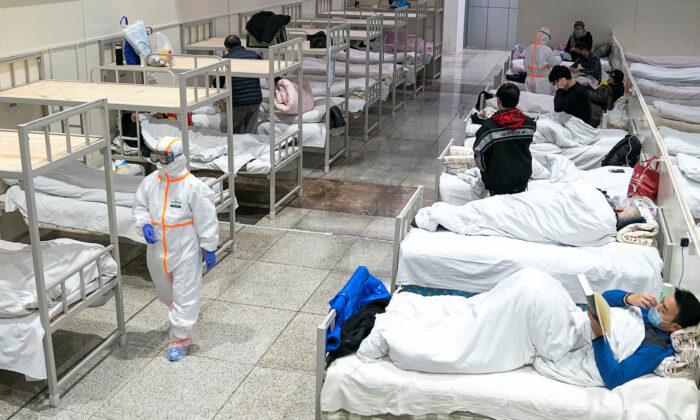14-Day Quarantine Is Not Enough
More and more countries have evacuated their citizens from Wuhan, and the standard routine is to place the evacuees under quarantine for 14 days and to monitor their health.If no symptoms show up within this period of time, they would be identified as uninfected.
Chinese state media have also reported on such cases.
A Shenzhen resident was found to have been infected with the coronavirus even after he showed no symptoms during the 14-day quarantine period.
This patient traveled to Wuhan on Jan. 20 and returned home to Shenzhen in the evening. On the same day, the Chinese authorities announced that the novel coronavirus can spread from person to person. Upon hearing the news, he went straight to a hotel upon arriving in Shenzhen and self-quarantined for 14 days. He developed no symptoms at that time. At the end of the quarantine period, he took a CT chest scan at one of the local hospitals. The result came out the next day, showing a 3-millimeter ground-glass opacity in his lungs.
Ground-glass opacity in the lungs indicates an infection and is a typical characteristic of the novel coronavirus.
The patient’s wife shared his story over Chinese social media WeChat, telling her friends to be extra careful.
She emphasized that her husband had absolutely no perceptible symptoms after being quarantined. “No fever, no coughing, no chest tightness, whatsoever. We all thought he would be safe if he appears to be fine in the first 14 days. It is such a big surprise,” she wrote.
Dr. George Ku, an immunology expert from Hong Kong, pointed out that a patient usually has no symptoms during the initial stage of infection of the novel coronavirus. When a patient starts to experience fever and shortness of breath, he has already developed pulmonary fibrosis.
‘Silent Carriers’
Li Xingwang, an expert from China’s National Health Commission, announced at a press conference on Jan. 28 that medical workers have noticed a number of individuals who show no symptoms but have been tested positive for the coronavirus. This group of patients were found when medical staff proactively screened those who have close contacts with previously diagnosed patients, regardless of whether or not they show symptoms. Based on clinical observations, this group of virus carriers, who appear to be normal and healthy, can infect others, especially those in close contact with them.In medical terms, they are usually called “silent carriers” or “silent spreaders.”
Li cited the story of a woman surnamed Lu, who went back to her hometown in Henan Province from Wuhan on Jan. 10 for the Chinese New Year holiday. For 19 days, Lu herself did not show any symptoms, just like the patient in Shenzhen and Guangxi, but five of her family members began to experience fever, coughing, and sore throat one after another.
The five people were diagnosed with the novel coronavirus when they sought treatment at a local hospital.
In the previous case in Guangxi, Dr. Lan had no symptoms but he passed the virus to his wife, who tested positive around the same time Lan was finally diagnosed.
By Feb. 10, medical staff from 14 provinces reported cases of individuals showing no symptoms but have been tested positive for the presence of the virus.
Non-Respiratory Related Symptoms and No Fever
Moreover, researchers in Wuhan reported that infected patients have exhibited non-respiratory related symptoms, such as diarrhea, chest pain, and headaches.Zhong Nanshan’s latest research paper pointed out specifically that more than 50 percent of the confirmed patients did not have a fever.
“Only 43.8 percent of the coronavirus patients had a fever at the early stage of the disease development,” the report said.
Recovered Patients Getting Infected Again
A professor surnamed Zhao shared a story about his friend and his family. This friend, his daughter and mother-in-law all recovered from the coronavirus on Jan. 31. He immediately accepted media interviews, and his family’s story gave hope to many Wuhan residents.However, when Zhao called his friend on Feb. 3, he did not pick up the phone, and responded with a brief text message that read, “[I feel] very tired and I am short of breath. I cannot talk much.”
False Negative in Diagnostic Testing
In a hospital designated for the treatment of the coronavirus, a patient caught the doctors’ attention as his CT scan image indicated he had a very serious viral infection in the lungs, but he was tested negative twice in RT-PCR (a gene sequencing) diagnostic tests. The third test confirmed a positive result, according to a Feb. 5 report from Chinese media Caijing.Life or Death Within Three Weeks
Dr. Peng Zhiyong, director of acute medicine at the Wuhan University South Central Hospital, is one of the front line doctors treating the coronavirus patients. Peng shared with Chinese media Caixin his observation from his recent clinical cases.According to Peng, when a patient starts to show symptoms, the next three weeks will determine his fate.
In the first week, the patient usually progresses from mild to serious symptoms.
During the second week, if the patient has a strong immune system, then he may recover; however, if his immune system is weak, then he may start to develop complications, which in turn will cause respiratory and organ failures.
By the third week, if the patient’s immune system has been destroyed by the viral attack, then he will eventually die from multiple organ failures. But some patients could recover if their immune system regains its function.





